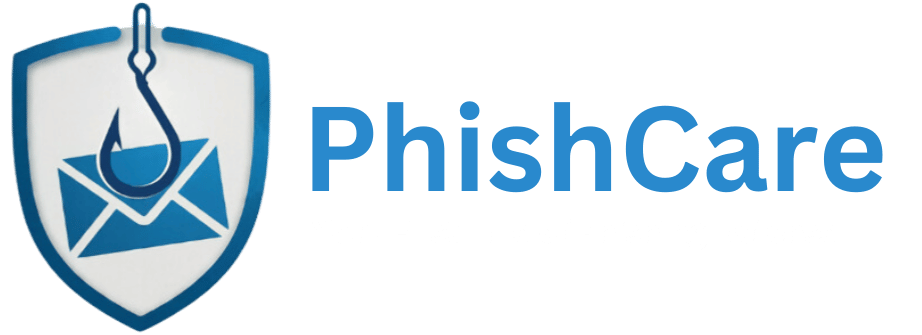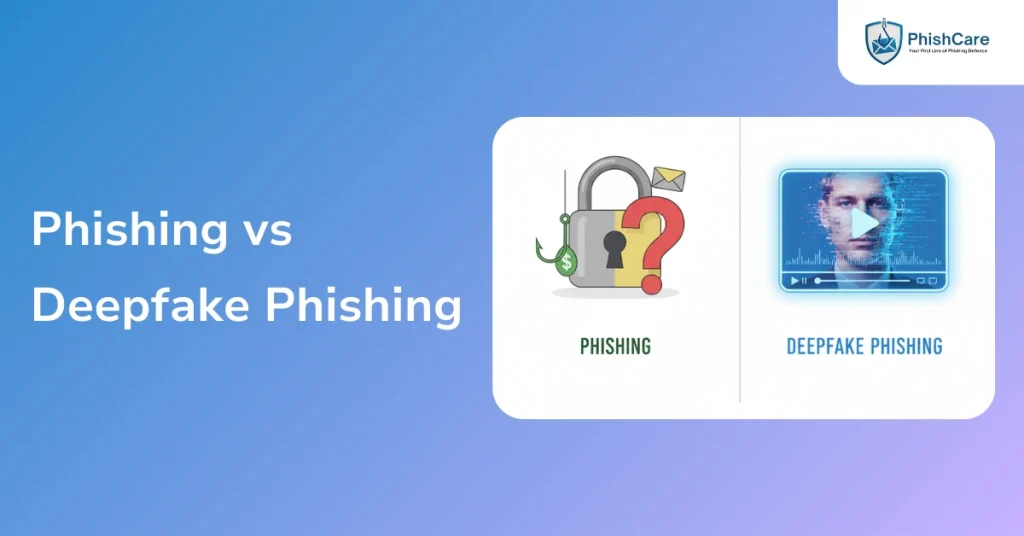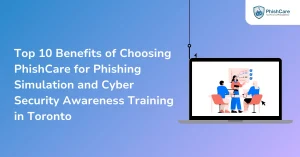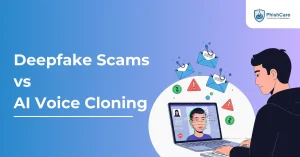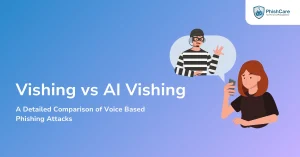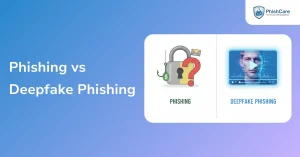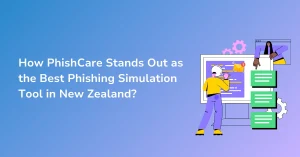Would you believe your CEO if they called asking you to transfer money right now? What if that voice wasn’t real at all? Creepy thought, isn’t it? Welcome to the world of deepfake phishing.
Not all cyber threats storm in like viruses or hackers smashing through firewalls. Many sneak in quietly through an email, a text, or even a video that feels just a little too real.
Phishing has been around for years. It’s the classic scam where attackers pretend to be trusted with names of a bank, an online store, even your favourite app just to steal things like passwords, credit card numbers, or bank details. At first glance, these messages look fine. But dig deeper, and you’ll notice they’re just bait dressed up with logos and urgent wording.
But here’s the twist. As technology grows smarter, so do the scams. Enter deepfake phishing. It’s not just about dodgy links anymore the game has changed. Attackers are now using AI to generate voices, faces, and videos that feel chillingly real. Both phishing and deepfake phishing play the same trick of deception. But deepfakes crank the impersonation up to a whole new, unnerving level.
What is a Phishing attack?
Phishing is still one of the sneakiest and most common tricks cybercriminals use to steal your private info. The name comes from fishing as you bait and someone bites. Sounds simple but It works. Here’s the catch, these scams are getting polished. They mimic the look, feel, and wording of real emails from banks, online stores, or social networks. Logos, fonts, urgent messages. All in. And yet, there’s always a hidden hook.
What they want is a serious collection of data like passwords, credit card numbers, bank details, date of birth, Social Security numbers, stuff like that. Once they’ve got it, they can drain money, impersonate you, or sell your data on to worse actors.
Picture this scenario, you receive an email that looks exactly like it’s from your bank. Logo is right. The tone is “official.” The email warns that your account will be locked unless you verify your details right away. You click. You enter your password. Only later, you realize it wasn’t the bank but it was a scammer.
The damage isn’t just theoretical. In 2024, Kaspersky blocked over 893 million phishing attempts globally and that’s up about 26% from the previous year. Emails with attachments, malicious links, impersonation of big brands as it was all used.
In India, the average cost of a data breach hit a record ₹195 million in 2024. Phishing and credential theft were the leading causes. Businesses aren’t just losing money. They’re losing trust. Phishing might feel like an old trick. But it’s sharp and getting sharper every day.
What is Deepfake Phishing?
If phishing is old-school bait and hook, deepfake phishing is the creepy new twist. Criminals now use artificial intelligence to build fake voices, videos, or images that feels shockingly real. We’re not talking about badly dubbed scam calls anymore. We’re talking about AI-generated voices that sound just like your boss. Or videos that look exactly like your CEO.
It gets unnerving when deepfake phishing doesn’t just throw you a dodgy email link.,but it talks like someone you know. It moves like someone you trust. And it asks you to do things that feel urgent and reasonable until you realize you’ve been tricked.
In 2020, fraudsters used a deepfake audio to impersonate a CEO’s voice and convinced a UK energy company employee to transfer $243,000 to a “supplier.” The voice was so convincing that the worker didn’t even question it. Creepy, right?
And this isn’t the only situation. Europol reported that deepfake scams caused over $35 million in losses in a single case in 2020, and incidents have been rising ever since. In 2023, a Hong Kong company lost $25 million after staff were duped by a deepfake video call that looked like top executives giving financial instructions.
Now, think about how hard it is to spot. An email might raise suspicion over typos, bad grammar, a strange link. But when you hear your manager’s exact voice asking for “urgent help”? Or see your CEO on a video telling you to move funds immediately? That’s a whole new level of manipulation.
Deepfake phishing blends high-tech fakery with old-school social engineering. And that combo is chilling. Because spotting the difference between real and fake isn’t just tricky anymore it’s nearly impossible.
Key Differences Between Traditional Phishing and Deepfake Phishing
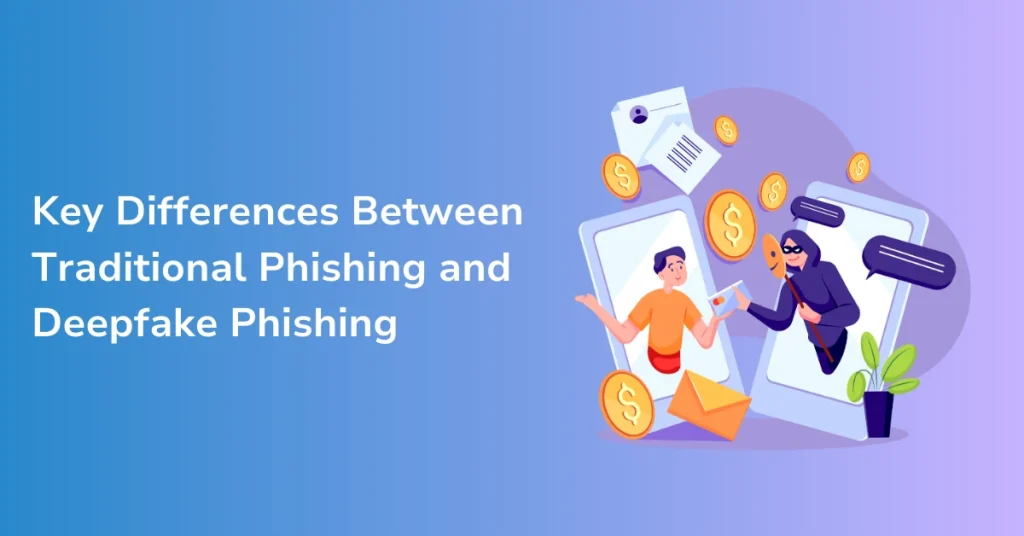
1. Method of Attack
Traditional phishing usually comes in the form of fake emails, text messages, or websites that look like they’re from trusted sources. Deepfake phishing, on the other hand, goes a step further by using AI-generated voices, videos, or images to impersonate real people. For example, while a traditional phishing email might pretend to be your bank asking you to “verify your account,” a deepfake scam could involve a phone call that sounds exactly like your boss asking you to transfer money.
2. Level of Realism
Traditional phishing relies on surface-level tricks like using logos, fonts, or urgent wording to look convincing. Often, careful observation can expose small errors, such as a misspelled email address or a suspicious link. Deepfake phishing, however, is far more realistic because AI makes the fake voice, face, or video almost identical to the real person. Picture a situation of getting a video call where the CEO’s face and voice seem perfectly real as spotting the scam becomes much harder.
3. Trust Factor
Phishing emails usually try to pressure people by creating urgency or fear, such as warning that “your account will be locked” unless you act immediately. Deepfake phishing instead plays on personal trust, pretending to be someone you know or respect. For instance, while a traditional phishing email might make you panic into clicking a link, a deepfake could trick you emotionally by sounding like a close friend asking for urgent help.
4. Ease of Spotting
Traditional phishing can often be detected with a bit of awareness by looking for typos, unusual wording, or checking whether the web address is genuine. Deepfake phishing is much harder to identify because it doesn’t just rely on text or visuals but mimics human emotions, tone, and behaviour. In other words, spotting a suspicious link is easier than realizing the voice on the other end of the phone isn’t actually your boss.
5. Impact Potential
The goal of traditional phishing is usually to steal personal information like passwords, credit card numbers, or login details from individuals. Deepfake phishing, however, poses an even bigger risk because it can target both individuals and organizations with large-scale scams. For example, an employee might hand over sensitive business data or transfer funds because they truly believe the request came from their CEO.
| Aspect | Traditional Phishing | Deepfake Phishing |
| Method of attack | Fake emails, texts, or websites pretending to be banks, shops, or social media sites. | AI-generated voices, videos, or images that copy real people. |
| Level of Realism | Relies on surface tricks like logos, fonts, or urgent words. Mistakes like typos often give it away. | AI makes the voice or video look and sound frighteningly real like your CEO on a Zoom call. |
| Trust Factor | Uses fear and urgency (“Your account will be locked if you don’t act now”). | Plays on trust. Pretends to be someone you know a friend, boss, or colleague and asking for urgent help. |
| Ease of Spotting | Can often be caught by checking details like spelling errors, strange email addresses, or fake links. | Much harder to spot. Mimics human tone, emotion, and behavior so well that the usual red flags don’t work. |
| Impact Potential | Mostly targets personal info like passwords, bank details, or credit card numbers. | Can cause bigger damage to both individuals and companies. |
Risks of Traditional Phishing vs Deepfake Phishing
1. Financial Loss
Phishing can burn a hole in your pocket fast. Someone clicks a fake link or enters card details on a spoofed website. The next minute, $500 or more is lost. But here’s the twist: deepfake phishing can hit much harder. We’re talking about convincing voice or video impersonations that lead entire businesses to send millions. For example, Arup, a UK engineering firm, lost $25 million after an employee was tricked by a deepfake video conference call from someone posing as an executive.
2. Data Theft
With old-school phishing, attackers aim for personal stuff: usernames, passwords, maybe your SSN or birth date. Bad enough. But deepfake phishing can open the doors to bigger systems like company records, private conversations, secret business docs. Imagine a fake video of your boss telling you to share internal files. That scale of leak can wreck more than just your bank balance.
3. Reputation Damage
If your personal account is compromised through phishing, you might feel embarrassed. But usually, it’s your problem alone. Deepfake phishing can taint others too like your colleagues, your company. Suppose a fake message spreads under the name of your CEO saying something false or damaging. Even if later it’s exposed as fake, the trust is already shaken. Customers, partners, employees all suffer.
4. Emotional Manipulation
Phishing often plays with creating fear like “You’ll lose access!” or “Pay up now!” It makes you panic. Deepfake phishing adds a creepier layer. It uses voices and faces you trust. Someone you know begging for help. Or sounding desperate. It hits closer to the heart. Makes you act before you think.
5. Difficulty of Detection
Classical phishing has telltale signs. Odd spelling, weird sender address, mismatched logos. You’ve learned to watch for those. But deepfake phishing? That’s where it gets unnerving. It mimics tone, facial cues, voice inflection. It looks and sounds right. So your brain doesn’t go “Wait a second.” And by the time you realize something’s off, the damage may already be done.
How to Protect Yourself from Phishing and Deepfake Attacks
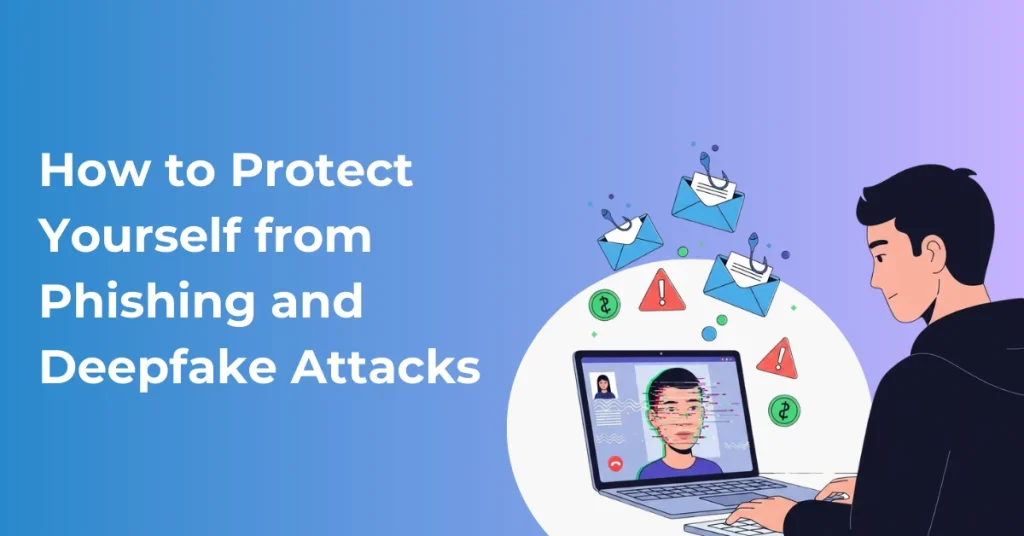
Spotting scams isn’t as easy as it used to be. It’s not just about dodgy links anymore the game has changed. But that doesn’t mean you’re helpless. There are some simple ways to shield yourself from these attacks.
1. Slow Down Before You Click or Respond
Scammers thrive on panic. “Click now!” “Your account will be locked!” That urgency is the bait. Take a breath. Verify the email address. Hover over links before clicking. A two-second pause can save you from weeks of trouble. It’s better to think twice before responding and understanding why the urgency all of a sudden.
2. Verify Requests Through Another Channel
If your “boss” emails asking for a wire transfer, don’t just hit reply. Call them directly. If a family member’s “voice” is asking for money, send them a quick text. Cross-check on another channel. In fact, according to the FBI, business email compromise often mixed with deepfakes led to over $2.4 billion in losses in 2021. Most of those could have been avoided with a simple second check.
3. Stay Alert for Red Flags
No technology is perfect. Deepfake videos often have small glitches: lips slightly out of sync, odd blinking, weird pauses in speech. It’s creepy, but if you look closely, you might spot the cracks. Just like how you detect flaws in phishing emails with grammar mistake, typos and links etc.
4. Use Multi-Factor Authentication (MFA)
Even if you accidentally give away your password, MFA can stop attackers from walking right in. It’s like having a second lock on the door. Sure, it’s one extra step, but it makes stealing your account much harder.
5. Keep Training Your “Human Firewall”
Companies can’t rely only on software. Employees need regular awareness training. The more familiar you are with scam tactics, the harder you are to trick. A 2022 Proofpoint report found that organizations with ongoing phishing simulations saw 60% fewer successful attacks compared to those with no training.
6. Demand Better Tech Defenses
AI isn’t just helping scammers, it’s helping defenders too. Voice authentication, deepfake detection tools, and email filtering systems are improving fast. Companies should invest in them. Individuals should keep devices updated and use reputable security software.
7. Trust Your Gut
This may sound old-school, but it works. If something feels off the wording, the urgency, the vibe of the request then its time to pause and verify. Scammers count on you ignoring that gut feeling. Don’t ignore your thoughts.
Conclusion
As technology continues to advance, the ways in which cybercriminals trick people are also evolving. Traditional phishing remains a common threat, preying on fear and urgency to steal personal information. But deepfake phishing represents a new, more sophisticated danger — one that exploits trust, emotions, and even human relationships to manipulate victims.
The key takeaway is that both types of attacks rely on deception, but the stakes are higher with deepfakes because they are harder to detect and can affect both individuals and entire organizations. Staying vigilant, verifying identities, and questioning unexpected requests — whether they come in an email, a call, or a video — are the best defenses against these modern scams.
Ultimately, awareness and caution are your strongest allies. Technology may evolve, but a careful, skeptical mind can always help you stay one step ahead of cybercriminals.
FAQs:
1. How can I tell if an email is a phishing attempt?
Answer: Check for small details like spelling mistakes, suspicious links, or unusual requests. If the email creates urgency (like “act now” or “your account will be blocked”), take a step back and verify directly with the organization before clicking anything.
2. Are deepfake phishing attacks really common?
Answer: They are not as widespread as traditional phishing yet, but they are growing quickly. As AI tools become more accessible, deepfake scams are becoming easier and cheaper to create — which means we’ll likely see more of them in the future.
3. What’s more dangerous: phishing or deepfake phishing?
Answer: Both are harmful, but deepfake phishing is considered more dangerous because it can convincingly impersonate people you know and trust. Traditional phishing is easier to spot if you’re careful, but deepfakes blur the line between real and fake.
4. How can individuals protect themselves from these attacks?
Answer: Always double-check before sharing personal or financial information. If you receive a strange call, video, or message even from someone familiar, verify through another channel (like calling their official number). Awareness is the best shield.
5. What should businesses do to reduce the risk of deepfake or phishing attacks?
Answer: Companies should provide regular training to employees, use multi-factor authentication, and create strict protocols for sensitive actions like money transfers. For example, requiring verbal and written confirmation before approving large transactions can help prevent scams.
